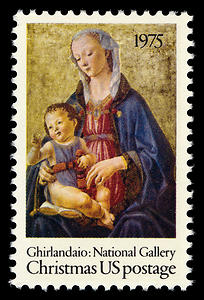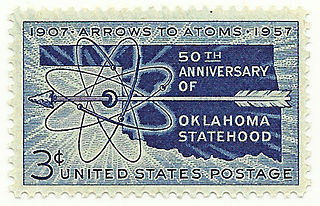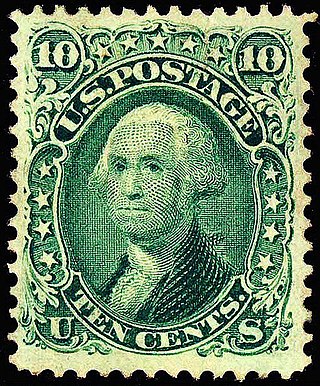This article needs additional citations for verification .(June 2007) |
Holiday stamps are a type of postage stamp issued to commemorate a particular religious festival or holiday.
This article needs additional citations for verification .(June 2007) |
Holiday stamps are a type of postage stamp issued to commemorate a particular religious festival or holiday.
Many nations in the world issue Christmas stamps intended for use on holiday mail.
In 1997 a joint issue was issued by Mexico, who issued one stamp, and the United States, who issued both a 32-cent and a 33-cent denomination. [1] Cinco de Mayo celebrates the defeat of the French Army by Mexican soldiers at the Battle of Puebla though some people believe it is the Mexican day of independence. [2]
Ukraine is among the countries that have issued a stamp commemorating Easter, a Christian holiday. [3]
The United States Postal Service issued a 34-cent stamp on the 1 September 2001 at the annual Islamic Society of North America's convention in Des Plaines, Illinois. It features gold Arabic calligraphy on a lapis background that commemorates two of the most important Muslim festivals: Eid ul-Fitr, marking the end of the month-long fast of Ramadan and Eid al-Adha, at the end of the pilgrimage to Mecca. During the festival, Muslims wish each other "Eid Mubarak," the phrase featured on the stamp. "Eid Mubarak" translates into English as "blessed festival," and can be paraphrased as "May your religious holiday be blessed." This phrase can be applied to both Eid al-Fitr and Eid al-Adha. This stamp was designed by the Islamic calligrapher Mohammed Zakariya. [4]
On 12 August 2011, a new version of the Eid stamp, a "forever" stamp for first-class mail, was issued. With a red background, its calligraphy (i.e., text) is distinctly different from the 2001 stamp with a blue background. On the forever stamp, the text in the upper left corner is "2011 USA", and text in the upper right, running vertically, reads "FOREVER". Text running across bottom reads "EID GREETINGS". [5]
Pakistan is among the other countries with an Eid stamp. [3]
| | This section needs expansion. You can help by adding to it. (May 2008) |

The U.S. Postal Service issued a 32-cent stamp on October 22, 1996, as a joint issue with Israel. [6] Hanukkah commemorates the revolt led by Judah Maccabee against the government of Antiochus IV in 165 BC. This initial printing produced 103.5 million stamps and in it was re-issued in 1999 in a 33-cent value.
The Israeli stamp employs the same multi-colored menorah design, by American Hannah Smotrich, a graduate of the Yale School of Art. Israel also issued a first-day cover as well as a souvenir sheet, which shows both stamps (pictured on left). As a unique feature, this was this first self-adhesive stamp in Israel.
In 2004, the U.S. issued another Hanukkah stamp depicting a photograph of a dreidel (a spinning toy with four sides), with the word 'Hanukkah' in the background. The dreidel shown was purchased in Jerusalem by an American couple. The stamp was first issued on October 15 in New York. [7] The initial version of the stamp has been reissued; in 2006 it was 39 cents, in 2007, it was 41 cents stamp, and in 2008 it was a 42 cent stamp.
In 2013 United States Postal Service issued a new version of Hanukkah stamp which depicted menorah again. The stamp was issued on November 19 in New York. [8]
| | This section needs expansion. You can help by adding to it. (May 2008) |

Many countries issue stamps to celebrate their Independence Day or Republic Day.
India celebrates its Independence on August 15, beginning with its first three stamps issued in 1947. Republic Day is celebrated on January 26, commencing with the four stamps issued in 1950.
Pakistan celebrates its Independence (Yaum e Azadi) on August 14, beginning with its first recess printed stamps.

Kwanzaa is a non-religious African-American festival which synthesizes and reinvents traditional African "first fruits" celebrations. The U.S. Postal Service issued the first 32 cent stamp designed by self-taught artist Synthia Saint James for Kwanzaa on October 22, 1997. [9] This design was revalued three times to 33-cent, 34-cent and 37-cent in 1999, 2001 and 2002, respectively. A total of 133 million Kwanzaa stamps were produced in 1997. [10] A second Kwanzaa stamp, a 37-cent self-adhesive value, was introduced on October 16, 2004, with a new design by Daniel Minter that was intended to convey "balanced formality with a celebratory, festive mood." [11] This stamp has been reissued; the 2006 was 39 cents, the 2007 value was 41 cents, the 2008 was 42 cents.
| | This section needs expansion. You can help by adding to it. (May 2008) |

Israel has issued its "festival" series of stamps every year to commemorate the Jewish New Year, Rosh Hashanah. In 1948, Israel's first festival stamps were designed by Otte Wallish and depicted LMLK seals stamped onto jars from the time of King Hezekiah (circa 700 BCE). The Rosh Hashanah stamps often display secular and patriotic motifs, such as bread, wine, olives, soldiers, kibbutzniks, Israeli dancing and the national library (1992). Fittingly, many series feature religious motifs, such as curtains for synagogue arks (1999), Hebrew Bible stories (1994), ushpizin of Sukkot (1997), Jewish lifecycle events (1995), and the orders the Mishnah (2006), with Nezikin pictured here. [12]
Several countries have issued love stamps for Saint Valentine's Day, such as; Belgium, France, Sweden, Norway and Denmark. [13] Collectors will often try to collect covers from romantically named towns. Perhaps the most well known, servicing more than 200,000 each year around Valentine's Day, is Loveland, Colorado, US.
In January 1985 and subsequent Januarys An Post, the Irish Post Office, started issuing love stamps for use on cards and letters for Saint Valentine's Day. The first pair of stamps issued depicted clouds and balloon (22p value) and hearts and flowers (26p value). [14] An Post continues to issue new designs each year.
| | This section needs expansion. You can help by adding to it. (May 2008) |

Several nations issue postage stamps to mark the Lunar New Year (or Chinese New Year). Typically appearing in January and February, issuing countries have included China, Taiwan, Hong Kong, Malaysia, Singapore, United States, New Zealand, Australia, Canada, and France.
The stamps usually depict the animal sign of that year, consisting of the sequence: Rat, Ox, Tiger, Rabbit, Dragon, Snake, Horse, Goat, Monkey, Rooster, Dog and Pig. The designs may be part of a set, or individually designed; for instance, since 1992 the US has been issuing Chinese New Year stamps using a common design type based on colored paper cutouts of the animals. In succeeding years, the U.S. Postal Service issued additional stamps until all twelve animals associated with the Chinese lunar calendar were represented. The calligraphic characters on these stamps may be translated into English as "Happy New Year". [15]
Hong Kong was one of the first countries to issue a commemorative stamp for the lunar new year since the 1960s (1967), but other countries have followed:
Most of these stamps consist of first-day covers, commemorative sheets, and multiple country brochures.
{{cite book}}: |work= ignored (help)
Kwanzaa is an annual celebration of African-American culture from December 26 to January 1, culminating in a communal feast called Karamu, usually on the sixth day. It was created by activist Maulana Karenga, based on African harvest festival traditions from various parts of West, East, as well as Southeast Africa. Kwanzaa was first celebrated in 1966. 21st century estimates of how many Americans celebrate Kwanzaa are varied, from as few as a half a million to as many as 12 million.

A postage stamp is a small piece of paper issued by a post office, postal administration, or other authorized vendors to customers who pay postage. Then the stamp is affixed to the face or address-side of any item of mail—an envelope or other postal cover —which they wish to send. The item is then processed by the postal system, where a postmark or cancellation mark—in modern usage indicating date and point of origin of mailing—is applied to the stamp and its left and right sides to prevent its reuse. Next the item is delivered to its addressee.

Postal service in the United States began with the delivery of stampless letters whose cost was borne by the receiving person, later encompassed pre-paid letters carried by private mail carriers and provisional post offices, and culminated in a system of universal prepayment that required all letters to bear nationally issued adhesive postage stamps.

A Christmas stamp is a postage stamp with a Christmas theme, intended for use on seasonal mail such as Christmas cards. Many countries of the world issue such stamps, which are regular postage stamps and are usually valid for postage year-round. They usually go on sale some time between early October and early December, and are printed in considerable quantities.

The history of the postage stamps and postal history of China is complicated by the gradual decay of Imperial China and the years of civil war and Japanese occupation in the 1930s and 1940s. In modern times, postal delivery is handled by China Post.

The system for mail delivery in the United States has developed with the nation. Rates were based on the distance between sender and receiver in the nation's early years. In the middle of the 19th century, rates stabilized at one price regardless of distance. Rates were relatively unchanged until 1968 when the price was increased every few years by a small amount. Comparing the increases with a price index, the cost of a first-class stamp has been steady. The seal of the Post Office Department showed a man on a running horse, even as railroads and, later, motorized trucks and airplanes moved mail. In 1971, the Post Office became the United States Postal Service, with rates set by the Postal Regulatory Commission, with some oversight by Congress. Air mail became standard in 1975. In the 21st century, prices were segmented to match the sorting machinery used; non-standard letters required slightly higher postage.

Postage stamps and postal history of the Canal Zone is a subject that covers the postal system, postage stamps used and mail sent to and from the Panama Canal Zone from 1904 up until October 1978, after the United States relinquished its authority of the Zone in compliance with the treaty it reached with Panama.

Non-denominated postage is a postage stamp intended to meet a certain postage rate, but printed without the denomination, the price for that rate. They may retain full validity for the intended rate, regardless of later rate changes, or they may retain validity only for the original purchase price. In many English-speaking countries, it is called non-value indicator or non-value indicated (NVI) postage. Introduced to reduce the cost of printing large issues of low-value stamps to "top-up" old issues, NVI stamps are used in many countries.

The Oklahoma Statehood Stamps were issued on June 14, 1957 and January 11, 2007 by the United States Postal Service. The U.S. postage stamps celebrate the 50th and 100th anniversaries of statehood being granted to the state of Oklahoma by the United States of America. Oklahoma was the 46th state to be granted statehood on November 16, 1907.

U.S. Special Delivery was a postal service paid for with additional postage for urgent letters and postal packets which are delivered in less time than by standard or first class mail service. Its meaning is different and separate from express mail delivery service. Essentially it meant that a postal packet was delivered from a post office to the addressee immediately once it arrived at the post office responsible for delivering it, rather than waiting for the next regular delivery to the addressee.

Postage stamps of Pakistan are those issued since Pakistan's independence in 1947. Pakistan Post has issued more than 600 sets and singles totalling more than 1300 stamps. Immediately after the independence of Pakistan in 1947, the new Pakistan government was preoccupied with setting up the government so British Indian stamps continued in use without an overprint as was the practice in other countries.
A Hanukkah stamp is a holiday stamp issued to commemorate Hanukkah. Since 1996, several Hanukkah-themed postage stamps have been issued, often jointly.

The postage stamps and postal history of Israel is a survey of the postage stamps issued by the state of Israel, and its postal history, since independence was proclaimed on May 14, 1948. The first postage stamps were issued two days later on May 16, 1948. Pre-1948 postal history is discussed in postage stamps and postal history of Palestine.
Lists of holidays by various categorizations.

Presidents of the United States have frequently appeared on U.S. postage stamps since the mid-19th century. The United States Post Office Department released its first two postage stamps in 1847, featuring George Washington on one, and Benjamin Franklin on the other. The advent of presidents on postage stamps has been definitive to U.S. postage stamp design since the first issues were released and set the precedent that U.S. stamp designs would follow for many generations.
Puerto Rico topics have been featured on the stamps of Spain and of the United States. Spanish stamps are found at Postage stamps and postal history of Puerto Rico.

Territories of the United States on stamps discusses commemorative postal issues devoted to lands that have been ceded to the nation or purchased by treaty in conjunction with both war and peace. Thirteen states have been created from colonial territories, two from independent republics, four from previous states in the Union, and an additional thirty-one from United States territories.

The history of Virginia through the colonial period on into contemporary times has been depicted and commemorated on postage stamps accounting for many important personalities, places and events involving the nation's history. Themes are particularly rich in early American and new nation history, historical landmarks, and Virginia-born presidents.

The U.S. Parcel Post stamps of 1912–13 were the first such stamps issued by the U.S. Post Office Department and consisted of twelve denominations to pay the postage on parcels weighing 16 ounces and more, with each denomination printed in the same color of "carmine-rose". Their border design was similar while each denomination of stamp bore its own distinctive image in the center (vignette). Unlike regular postage items, whose rates were determined by weight in ounces, Parcel Post rates were determined and measured by increments in pounds. The new stamps were soon widely used by industry, farmers and others who lived in rural areas. Partly owing to some confusion involving their usage, their exclusive use as Parcel Post stamps proved short lived, as regular postage stamps were soon allowed to be used to pay parcel postage rates.

The Antarctic Treaty issue is a postage stamp that was issued by the United States Post Office Department on June 23, 1971. Designed by Howard Koslow, it commemorates the tenth anniversary of the Antarctic Treaty, and is notable as Koslow's first postage stamp design.